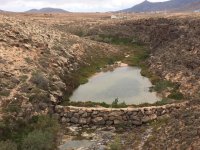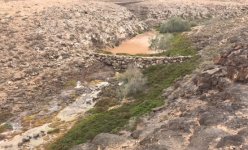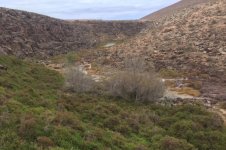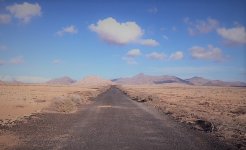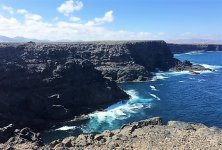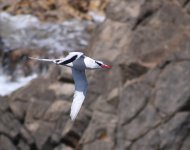wolfbirder
Well-known member
A fairly short report regards a family holiday booked in March, for ten days in late-May at the All-inclusive resort of Pierre & Vacances 'Origo Mare' resort at Majanicho on the extreme Northern coast of the island. This was booked via www.booking.com, which allows you to book and amend bookings often up to shortly before you leave. In fact I cancelled our original booking only to rebook exactly the same holiday accommodation with the same All-inclusive option a few weeks after I made it, as prices had by then dropped £300 (for the 4 of us). Flights via Ryan Air from East Midlands were good and on time. But I couldn't get the low winter rates many twitchers had previously obtained over the winter months, who had come to see the Dwarf Bittern - a bird I had no expectation of seeing as I expected it to have long gone by the time I visited.
This was not a birding holiday, it was a relaxing family break, but of course my wife understands my twitching mentality and the fundamental need to go out. She recognises the signs - I sit up on the sun bed for around 3-4 minutes looking around and trying to look vaguely uncomfortable. She knows its "twitcher-itis", and to be fair she usually says - "Go on then, I expect you back by 3pm".
My first impressions of Fuerteventura are that it is hilly, barren, and bleak, with a number of old volcanic cones, but let me make it clear I did not go south of the airport. I have been to neighbouring Lanzarote and found it more attractive and the villages there are prettier. The hotel itself offered semi-permanent views of Bertholot's Pipits and Spanish Sparrows, as well as Collared Doves and Yellow-Legged Gulls overhead. I also located single Hoopoe, Southern Grey Shrike (koenigi- Desert Grey Shrike race), Trumpeter Finch, & 2 Swallows. Barbary Squirrels were easy to find on the complex and on the last day I also saw a Canarian Shrew.
My list only stretched to 35 species, which were seen during 6 trips out, each time for 2-4 hours only, and at various times of the day.
At the nearby fishing village of MAJANICHO I often found a few Dunlin, Kentish Plovers, and a Little Egret. Offshore but quite distant, Cory's Shearwaters passed by, but I could not even see if there were any smaller seabirds amongst them, as the shearwaters themselves were not close.
I also visited TINDAYA PLAINS on 2 occasions, as far as LA HUESILLA viewpoint where there were dramatic clifftop views. On the plains I failed to find any Cream-Coloured Coursers sadly, and in fact bird life was sparse. I located 4 Houbara Bustards as I drove around the tracks, but only one was close. 2 Black-Bellied Sandgrouse, 2 Stone Curlews, and 15 Lesser Short-toed Larks were seen as well. Off the cliffs I saw 2 Barbary Falcons chasing Rock Doves, and Yellow-Legged Gulls were the only birds routinely seen off shore. I had obtained supreme views of the bustards and coursers at El Rubicon plain, Playa Blanca, Lanzarote, several years previously, so they were not my priority this time, in the short period I had.
BARRANCO DE RIO CABRAS Accessed off the FV20, this site was visited 4 times when I discovered that the Dwarf Bittern was last seen on 17th May!! This really surprised me, but I feared it had gone when I failed to locate it despite routinely checking out the areas up to 200 metres either end of both dam walls, and quietly walking along the clifftops overlooking the mainly dry canyon below. There was one large pool of water at one end, and streams, brooks, or small standing pools of water just below each dam wall. I also sat for hours on end overlooking it, not breaking the sky-line as advised. I saw no other birders here, nor in fact anywhere. The same birds were regularly encountered here each visit - up to 20 Trumpeter Finches, several Spanish Sparrows, 4 Egyptian Vultures, 2 Moorhens, 4 Turtle Doves, 4 Collared Doves, Rock Doves, 2 Hoopoes, 2 Desert Grey Shrikes, single Purple Heron, 2-4 Local-race Buzzards, 2-3 LRP's, 6 very-noisy Black-winged Stilts with a few young, 2 Ruddy Shelducks with 5 fully-grown young, several Pallid and Plain Swifts, a couple of Spectacled Warblers, and 6-8 Fuerteventura Stonechats of various age and hence different plumage features. A couple of Barbary Squirrels were here on the rocks, and domestic goats on the hillsides that often seemed as if they were trying to speak. But not until 28/5 at 8.30pm did I see the Dwarf Bittern - and even then it was just for 2-3 seconds! Most unsatisfactory. I was walking quietly along the north-side clifftop, looking down during one last check of its favoured area by the upper dam. I looked down into the small pool by the upper dam, and there stood a small bittern-shaped bird. It saw me and scuttled deep into or even underneath its favoured bush before I could even lift my binoculars. I sat and waited until dusk but although I thought I heard it calling, I did not see it again. I even tried again on the following cloudy morning, scrutinising the same bush from the more gentle-sloping rocky slope opposite, but with no luck. But the location was exactly the spot / bush where around 50% of the 20-plus sightings on www.observation.org reported it from. Earlier I had heard a single splash from the blind side of the bush when I was sat above it, and there was no other bird around. In fact, the only other birds I ever saw by this drier upper dam wall were a couple of LRP's and a few Trumpeter Finches. So all in all, very very frustrating. A tick but not a satisfactory one. It seems it has become far more elusive now, and I believe it day-roosts underneath its favoured bush now that water-levels have dropped a bit.
Now, I also vaguely hoped to see another very exciting WP bird - Red-Billed Tropicbird. Over the past year it has become fairly common knowledge that they could be encountered around Fuerteventura and Lanzarote, notably offshore from the Fuerteventura village of EL COTILLO. Colonising pairs have been reported. In the weeks before we came to the island, I surfed the net to see if I could find further information, and came across these 2 snippets of information: -
www.twitter.com/GIC_Mar/status/991996653451333632
This webpage by Marcel Gil highlighted that expert Mala Praxis had GPS-satellite-tagged the 3 pairs reported to be colonising together, by mountain-climbing down the precipitous cliff-face to the out-of-view birds that are nesting in deep crevices. It is intended to identify the location where these birds actively feed.
This action faced local criticism from local-ornithologists, who were anxious that disturbance at such a critical time might adversely affect any attempted colonisation.
The Canary Islands Rare Birds Facebook Group were particularly critical: -
https://en-gb.facebook.com/rarebirdscanaryislands/
Go to the post (currently the latest one) from 3/5/18, and select "See more" for conversion to English language comment.
So from this "in the public domain" information I knew they were likely to be present along or by the cliffs on the NW coast of Fuerteventura! Though, it has to be remembered that they cannot be located at any nest-site as they are said to be out-of-view, but still I hoped I could connect if I was lucky. The other problem is that they spend long periods way out at sea and thus again, out of view for long spells. Nevertheless, I tried on 3 occasions at different points along the NW coast. There is a clearly-driveable, rough track that runs alongside, or just inland of the coast for several miles southward from El Cotillo, and also there is a track that runs from TINDAYA village out to the LA HUESILLA viewpoint. Both lead to good stretches of cliffs along the NW coast of the island, but the tracks are broken-up and bumpy at points, so it is your calculated gamble bearing in mind that some car hire companies do not officially permit you to go onto such tracks. Us birders understand this -.
-.
I managed fine in my ford Focus. If you walk for more than 10 minutes, do make sure you take water and ensure you put sun-tan lotion on as the cool breeze is extremely deceptive and can badly burn you. As my legs and arms found out.
At around 5pm on 21/5, I located 3 adult Red-Billed Tropicbirds at a distance of half-a-mile, circling around distant cliffs, but identifiable because of their obvious long tails feathers. On 22/5 I was particularly fortuitous as a single adult Red-Billed Tropicbird flew slowly past the cliff-face I was walking along at about 11am, at a distance of just 70-100 metres away, and it remained in view for around 10-15 seconds, and I was able to scope it for around 3-4 seconds obtaining 'dream' views before it flew behind a pertruding cliff. An absolutely fantastic moment. I stayed here for an hour but unfortunately saw no others at all. I do have a rough idea where they are likely to be encountered, but when I returned between 6-7pm a few days later there was no sign of any at all. So if they are all at rest on the cliff-face, you may not encounter any as they are tucked away in deep recesses within it. Long-hour vigils may be necessary to connect.
I do hope the actions of these experts have not caused long-term damage to the colonisation-process here. As we speak, the answer is not crystal-clear to me, as I failed to locate any on rock-faces. But the two links above will hopefully update interested people regards the situation in due course.
Overall, I was thrilled with the birds seen on what was not a birding holiday, but I hope it gives some hope to other birders visiting the island. If you have any questions, I am happy to further help any 'known-birders' (on Birdforum) who will respect the situation, via PM. I cannot reveal more here unfortunately. I am sure you will understand that.
Photos below:-
1) Barranco de Rio Cabras - a view of the main pool of water, with the lower dam wall at the bottom, and the drier dam wall near the top.
2) A view of the upper dam, and just before it is the bush where the Dwarf Bittern regularly favours.
3) Another view of the bush the bittern favours, but of course here you are on the blind side.
4) A view of the Tindaya plains, taken from the track down that connects Tindaya with La Huesilla viewpoint.
5) A view over the extensive cliffs along NW Fuerteventura.
This was not a birding holiday, it was a relaxing family break, but of course my wife understands my twitching mentality and the fundamental need to go out. She recognises the signs - I sit up on the sun bed for around 3-4 minutes looking around and trying to look vaguely uncomfortable. She knows its "twitcher-itis", and to be fair she usually says - "Go on then, I expect you back by 3pm".
My first impressions of Fuerteventura are that it is hilly, barren, and bleak, with a number of old volcanic cones, but let me make it clear I did not go south of the airport. I have been to neighbouring Lanzarote and found it more attractive and the villages there are prettier. The hotel itself offered semi-permanent views of Bertholot's Pipits and Spanish Sparrows, as well as Collared Doves and Yellow-Legged Gulls overhead. I also located single Hoopoe, Southern Grey Shrike (koenigi- Desert Grey Shrike race), Trumpeter Finch, & 2 Swallows. Barbary Squirrels were easy to find on the complex and on the last day I also saw a Canarian Shrew.
My list only stretched to 35 species, which were seen during 6 trips out, each time for 2-4 hours only, and at various times of the day.
At the nearby fishing village of MAJANICHO I often found a few Dunlin, Kentish Plovers, and a Little Egret. Offshore but quite distant, Cory's Shearwaters passed by, but I could not even see if there were any smaller seabirds amongst them, as the shearwaters themselves were not close.
I also visited TINDAYA PLAINS on 2 occasions, as far as LA HUESILLA viewpoint where there were dramatic clifftop views. On the plains I failed to find any Cream-Coloured Coursers sadly, and in fact bird life was sparse. I located 4 Houbara Bustards as I drove around the tracks, but only one was close. 2 Black-Bellied Sandgrouse, 2 Stone Curlews, and 15 Lesser Short-toed Larks were seen as well. Off the cliffs I saw 2 Barbary Falcons chasing Rock Doves, and Yellow-Legged Gulls were the only birds routinely seen off shore. I had obtained supreme views of the bustards and coursers at El Rubicon plain, Playa Blanca, Lanzarote, several years previously, so they were not my priority this time, in the short period I had.
BARRANCO DE RIO CABRAS Accessed off the FV20, this site was visited 4 times when I discovered that the Dwarf Bittern was last seen on 17th May!! This really surprised me, but I feared it had gone when I failed to locate it despite routinely checking out the areas up to 200 metres either end of both dam walls, and quietly walking along the clifftops overlooking the mainly dry canyon below. There was one large pool of water at one end, and streams, brooks, or small standing pools of water just below each dam wall. I also sat for hours on end overlooking it, not breaking the sky-line as advised. I saw no other birders here, nor in fact anywhere. The same birds were regularly encountered here each visit - up to 20 Trumpeter Finches, several Spanish Sparrows, 4 Egyptian Vultures, 2 Moorhens, 4 Turtle Doves, 4 Collared Doves, Rock Doves, 2 Hoopoes, 2 Desert Grey Shrikes, single Purple Heron, 2-4 Local-race Buzzards, 2-3 LRP's, 6 very-noisy Black-winged Stilts with a few young, 2 Ruddy Shelducks with 5 fully-grown young, several Pallid and Plain Swifts, a couple of Spectacled Warblers, and 6-8 Fuerteventura Stonechats of various age and hence different plumage features. A couple of Barbary Squirrels were here on the rocks, and domestic goats on the hillsides that often seemed as if they were trying to speak. But not until 28/5 at 8.30pm did I see the Dwarf Bittern - and even then it was just for 2-3 seconds! Most unsatisfactory. I was walking quietly along the north-side clifftop, looking down during one last check of its favoured area by the upper dam. I looked down into the small pool by the upper dam, and there stood a small bittern-shaped bird. It saw me and scuttled deep into or even underneath its favoured bush before I could even lift my binoculars. I sat and waited until dusk but although I thought I heard it calling, I did not see it again. I even tried again on the following cloudy morning, scrutinising the same bush from the more gentle-sloping rocky slope opposite, but with no luck. But the location was exactly the spot / bush where around 50% of the 20-plus sightings on www.observation.org reported it from. Earlier I had heard a single splash from the blind side of the bush when I was sat above it, and there was no other bird around. In fact, the only other birds I ever saw by this drier upper dam wall were a couple of LRP's and a few Trumpeter Finches. So all in all, very very frustrating. A tick but not a satisfactory one. It seems it has become far more elusive now, and I believe it day-roosts underneath its favoured bush now that water-levels have dropped a bit.
Now, I also vaguely hoped to see another very exciting WP bird - Red-Billed Tropicbird. Over the past year it has become fairly common knowledge that they could be encountered around Fuerteventura and Lanzarote, notably offshore from the Fuerteventura village of EL COTILLO. Colonising pairs have been reported. In the weeks before we came to the island, I surfed the net to see if I could find further information, and came across these 2 snippets of information: -
www.twitter.com/GIC_Mar/status/991996653451333632
This webpage by Marcel Gil highlighted that expert Mala Praxis had GPS-satellite-tagged the 3 pairs reported to be colonising together, by mountain-climbing down the precipitous cliff-face to the out-of-view birds that are nesting in deep crevices. It is intended to identify the location where these birds actively feed.
This action faced local criticism from local-ornithologists, who were anxious that disturbance at such a critical time might adversely affect any attempted colonisation.
The Canary Islands Rare Birds Facebook Group were particularly critical: -
https://en-gb.facebook.com/rarebirdscanaryislands/
Go to the post (currently the latest one) from 3/5/18, and select "See more" for conversion to English language comment.
So from this "in the public domain" information I knew they were likely to be present along or by the cliffs on the NW coast of Fuerteventura! Though, it has to be remembered that they cannot be located at any nest-site as they are said to be out-of-view, but still I hoped I could connect if I was lucky. The other problem is that they spend long periods way out at sea and thus again, out of view for long spells. Nevertheless, I tried on 3 occasions at different points along the NW coast. There is a clearly-driveable, rough track that runs alongside, or just inland of the coast for several miles southward from El Cotillo, and also there is a track that runs from TINDAYA village out to the LA HUESILLA viewpoint. Both lead to good stretches of cliffs along the NW coast of the island, but the tracks are broken-up and bumpy at points, so it is your calculated gamble bearing in mind that some car hire companies do not officially permit you to go onto such tracks. Us birders understand this
I managed fine in my ford Focus. If you walk for more than 10 minutes, do make sure you take water and ensure you put sun-tan lotion on as the cool breeze is extremely deceptive and can badly burn you. As my legs and arms found out.
At around 5pm on 21/5, I located 3 adult Red-Billed Tropicbirds at a distance of half-a-mile, circling around distant cliffs, but identifiable because of their obvious long tails feathers. On 22/5 I was particularly fortuitous as a single adult Red-Billed Tropicbird flew slowly past the cliff-face I was walking along at about 11am, at a distance of just 70-100 metres away, and it remained in view for around 10-15 seconds, and I was able to scope it for around 3-4 seconds obtaining 'dream' views before it flew behind a pertruding cliff. An absolutely fantastic moment. I stayed here for an hour but unfortunately saw no others at all. I do have a rough idea where they are likely to be encountered, but when I returned between 6-7pm a few days later there was no sign of any at all. So if they are all at rest on the cliff-face, you may not encounter any as they are tucked away in deep recesses within it. Long-hour vigils may be necessary to connect.
I do hope the actions of these experts have not caused long-term damage to the colonisation-process here. As we speak, the answer is not crystal-clear to me, as I failed to locate any on rock-faces. But the two links above will hopefully update interested people regards the situation in due course.
Overall, I was thrilled with the birds seen on what was not a birding holiday, but I hope it gives some hope to other birders visiting the island. If you have any questions, I am happy to further help any 'known-birders' (on Birdforum) who will respect the situation, via PM. I cannot reveal more here unfortunately. I am sure you will understand that.
Photos below:-
1) Barranco de Rio Cabras - a view of the main pool of water, with the lower dam wall at the bottom, and the drier dam wall near the top.
2) A view of the upper dam, and just before it is the bush where the Dwarf Bittern regularly favours.
3) Another view of the bush the bittern favours, but of course here you are on the blind side.
4) A view of the Tindaya plains, taken from the track down that connects Tindaya with La Huesilla viewpoint.
5) A view over the extensive cliffs along NW Fuerteventura.
Attachments
Last edited:




